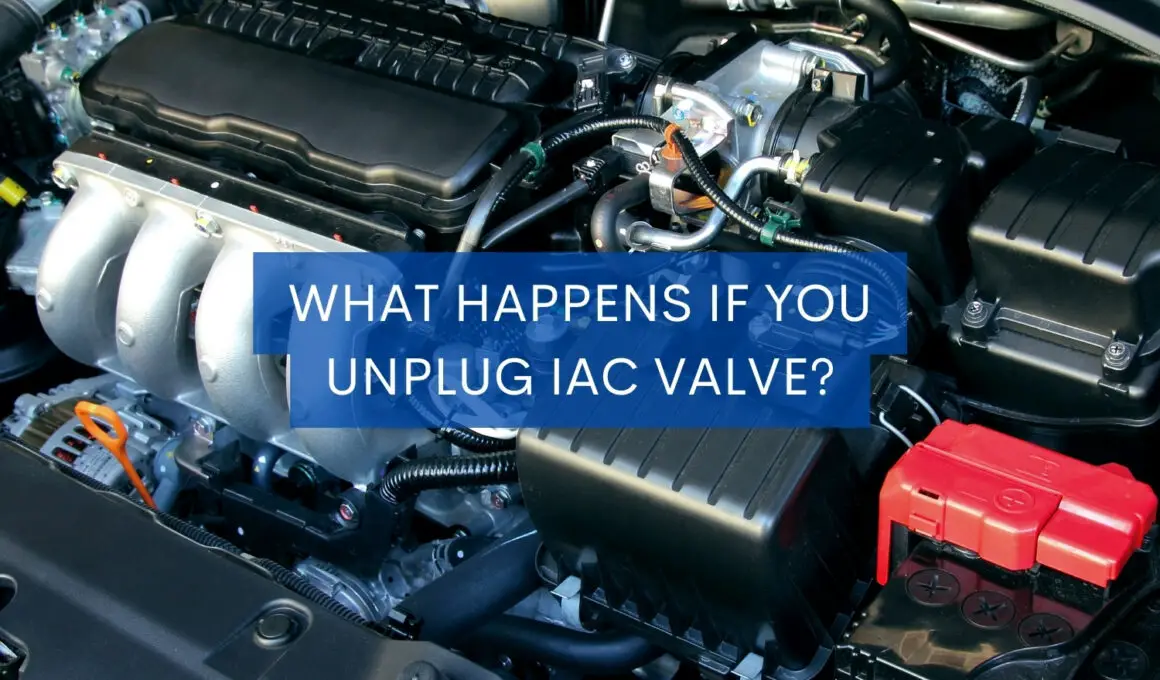In This Article Show
As an experienced mechanic with over a decade in the field, I’ve encountered a broad spectrum of vehicle issues and queries from car owners. One question that seems to come up frequently is related to the Idle Air Control (IAC) valve, a critical but often overlooked component of most modern vehicles.
Now, you might wonder, “What is the IAC valve, and why is it important?” To put it simply, the IAC valve is responsible for managing your engine’s idle speed. When functioning properly, it ensures your vehicle runs smoothly even when not in motion.
But what happens if you unplug this small but mighty component? That’s the crux of what we’re going to explore today.
Over my 13 years in the automotive industry, I’ve dealt with my fair share of IAC valve situations – from regular maintenance to complete replacements and unplugged valves.
It’s essential to understand the potential implications of an unplugged IAC valve, how to identify it, and what steps you should take if you find yourself in this situation.
What is an IAC Valve?
For those not well-versed in automobile mechanics, diving into your vehicle’s intricate systems and components might seem daunting. But don’t worry – I’m here to simplify things. Remember, I’ve spent over 13 years in the field, encountering and solving many car issues.
Now, onto the main topic at hand – the Idle Air Control (IAC) Valve. Nestled within your engine’s complex layout, the IAC valve is a crucial component that controls the engine’s idle speed. This is achieved by regulating air flow around the closed throttle plate.
Essentially, it keeps your engine running smoothly when your vehicle is idle – say, when you’re at a stoplight or stuck in traffic. It adjusts the engine’s operation based on the amount of load it’s under, whether it’s powering the air conditioner, the heater, or the headlights.
It’s a compact, electrically controlled component often found near the intake manifold. It adjusts the air passage by altering its position, controlling idle speed. The car’s computer continuously manages the IAC valve’s operation, or the Engine Control Unit (ECU), which makes adjustments based on parameters such as engine temperature and electrical load.
The IAC valve is, without a doubt, a critical element for your vehicle’s overall performance and efficiency. Unplugging it, as you might already guess, can significantly change your car’s operation. But what are these changes? That’s what we’re going to delve into in the next section.
The Impact of Unplugging the IAC Valve
With over 13 years of professional experience as a mechanic, I can’t stress enough the importance of each and every component in your vehicle. Unplugging or tampering with these components without a solid understanding of their functions can lead to unwanted consequences.
When it comes to the IAC valve, unplugging it can have immediate and long-term effects on your vehicle’s performance. Here’s what generally happens:
Altered Idle Speed
The primary function of the IAC valve is to regulate the engine’s idle speed. If it’s unplugged, the engine control unit (ECU) loses its ability to control the idle speed. This often results in an erratic or unstable idle, fluctuating engine speed.
Engine Stalling
Without the IAC valve’s input, the ECU may not be able to compensate for additional loads like the air conditioning or power steering. This could result in the engine stalling, particularly when idling or during low-speed maneuvers.
Difficult Cold Start
The IAC valve also plays a key role when starting the engine, especially in cold conditions. Without it, you might find your car harder to start, and even when it does, it might not run smoothly.
Decreased Fuel Efficiency
The IAC valve contributes to optimal fuel efficiency by controlling the air-fuel mixture at idle. This mixture can become imbalanced when unplugged, leading to reduced fuel efficiency.
Potential Damage to the Engine
Running the engine without a properly functioning IAC valve over time could lead to more serious damage. For example, frequent stalling can result in excessive wear on the starter motor and the engine.
Unplugging the IAC valve essentially forces the ECU to run the engine without all the necessary data, putting the vehicle’s performance and health at risk. As we dive into the next section, we’ll explore some of the symptoms that might indicate your IAC valve is unplugged or malfunctioning.

Symptoms of a Bad or Unplugged IAC Valve
Awareness of bad or unplugged IAC valve symptoms can be a lifesaver. It helps you quickly identify and address the issue before it escalates into more serious problems. Here are some common signs you should keep an eye out for:
Erratic Idle Speed
An unstable or erratic idle speed is the most common symptom of an unplugged IAC valve. If your engine’s RPM fluctuates wildly when your vehicle is stationary, it might be a sign that the IAC valve is unplugged or malfunctioning.
Frequent Stalling
Another common symptom is frequent stalling, especially when the engine is under load. This could occur when running the air conditioning, the headlights, or maneuvering at low speeds.
Difficulty Starting the Engine
If your vehicle struggles to start, especially in colder conditions, it could be due to an unplugged IAC valve. The engine might eventually start, but it may run roughly.
Check Engine Light
Modern vehicles have systems that monitor the engine’s performance and other components. If the IAC valve is unplugged or faulty, it may trigger the Check Engine Light on your dashboard.
Reduced Fuel Efficiency
If your vehicle is guzzling more fuel than usual, it might be due to an unplugged IAC valve. Remember, the IAC valve plays a significant role in maintaining optimal fuel efficiency.
Knowing these symptoms will enable you to take prompt action if you ever face a problem with your IAC valve.
Steps to Take if Your IAC Valve is Unplugged or Malfunctioning
Identifying a problem is only the first step. The next crucial step is knowing how to address it. If you suspect your IAC valve is unplugged or malfunctioning, here are the steps you should follow:
Confirm the Symptoms
The first step is to ensure that the symptoms you’re experiencing are indeed due to the IAC valve. Recall the symptoms mentioned in the previous section: erratic idle speed, frequent stalling, difficulty starting the engine, a lit Check Engine Light, and reduced fuel efficiency. If you observe any or a combination of these, it might be an IAC valve issue.
Inspect the IAC Valve
If you have basic mechanical skills and the right tools, you can attempt to inspect the IAC valve yourself. It’s typically located near the intake manifold.
Check if it’s unplugged or visibly damaged. However, remember that not all problems might be apparent to the naked eye.
Consult a Professional
If you’re not confident in your mechanical skills, or if the IAC valve appears to be plugged in and undamaged, it’s best to consult a professional mechanic. They can run a thorough diagnostic and confirm if the problem lies with the IAC valve.
Decide on the Next Steps
If it’s confirmed that the IAC valve is unplugged or faulty, you need to decide whether to re-plug or replace it. Re-plugging might resolve the issue if the valve is in good condition. However, if the valve is faulty, it must be replaced.
How to Replace or Plug Back an IAC Valve
If your IAC valve is confirmed to be unplugged or faulty and needs to be replaced, you have two options. You can either take your vehicle to a professional mechanic, or if you have the necessary skills and tools, you can handle it yourself.
Here is a general guide on how to replace or re-plug an IAC valve:
Materials Needed:
- Replacement IAC valve (if necessary)
- Basic tool set (screwdriver, wrenches)
- Clean cloth
- Throttle body cleaner (optional).
Steps:
Locate the IAC Valve
The IAC valve is typically found on or near the vehicle’s throttle body. Refer to your vehicle’s manual if you’re unsure of its location.
Disconnect the Battery
Before you start working on any electrical component, always disconnect the vehicle’s battery to prevent accidental shocks.
Remove the Electrical Connector
Once you’ve located the IAC valve, the first step is to remove the electrical connector plugged into it. This should pull off, but be careful not to pull on the wires themselves.
Inspect the Connector
Check the connector for any signs of damage or corrosion. If you suspect that the IAC valve was unplugged, this might be where the issue lies.
Remove the IAC Valve
The IAC valve is usually held in place with screws or bolts. Remove these and carefully take out the valve.
Inspect or Replace the IAC Valve
Inspect the valve for signs of wear or damage. If you’re re-plugging the valve, you can clean it with a throttle body cleaner before reinstallation. However, if the valve is damaged, you’ll need to replace it with a new one.
Install the New or Cleaned IAC Valve
Position the valve back in place and secure it with the screws or bolts. Ensure it is firmly installed.
Reconnect the Electrical Connector
Reconnect the electrical connector to the IAC valve.
Reconnect the Battery
Once everything is back in place, you can reconnect the vehicle’s battery.
Test Your Vehicle
Start your vehicle and let it run for a few minutes. Check if the symptoms you noticed earlier have been resolved.
Remember, this is a general guide, and the exact process can vary based on the make and model of your vehicle. If you feel uncomfortable performing these steps at any point, it’s best to consult a professional mechanic.
Preventive Measures to Avoid Issues with Your IAC Valve
As with most vehicle components, preventive maintenance is key when it comes to the IAC valve. By following a few simple practices, you can avoid unplugging or damaging the IAC valve and extend its lifespan. Here are some preventive measures you should consider:
Regular Vehicle Maintenance
Regular maintenance is crucial for your vehicle’s overall health. This includes oil changes, filter replacements, and checks of various components, including the IAC valve.
Keep the Throttle Body Clean
The IAC valve is usually located in or near the throttle body, and a dirty throttle body can negatively affect its performance. Regular cleaning of the throttle body can keep the IAC valve functioning properly.
Be Gentle
The IAC valve is a relatively small and sensitive component. If you’re doing any work near it, be careful not to knock it or its electrical connector loose.
Listen for Signs
An unplugged or faulty IAC valve gives off several signs, such as erratic idle speed or engine stalling. You can prevent further damage by being observant and taking immediate action when you notice these symptoms.
Professional Inspection
If you’re uncomfortable inspecting the IAC valve yourself, having it checked by a professional during regular maintenance can help catch any potential issues early.
Remember, prevention is always better than cure, especially regarding your vehicle. By taking these preventive measures, you can ensure the longevity of your IAC valve and maintain the overall performance of your vehicle.
Conclusion
To wrap things up, the Idle Air Control (IAC) Valve is an essential component in your vehicle that maintains the engine’s idle speed. Unplugging it can lead to a variety of issues, including erratic idle speed, frequent stalling, difficulty in starting the engine, a reduction in fuel efficiency, and potential long-term engine damage.
Awareness of the symptoms of an unplugged or faulty IAC valve, knowing how to address the issue, and implementing preventive measures can all contribute to your vehicle’s overall health and performance.
With that said, we hope this guide has helped broaden your understanding of what happens if you unplug the IAC valve, and what you can do about it.











